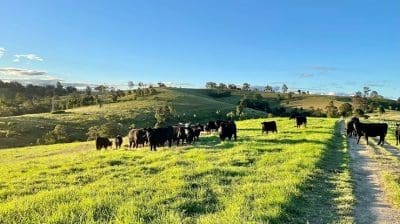CSIRO research has put the relevance of the red meat industry’s target to reach “carbon” neutrality by 2030 back in the spotlight.

CSIRO research published by Meat & Livestock Australia last week shows Australia’s cattle and sheep industries are well on track to achieve “climate” neutrality by 2026.
However, the same paper also suggests the target of carbon neutrality by 2030 will be harder to achieve by 2030 with the tools the industry has available in the lead up to that date.
The study has drawn attention to whether carbon neutrality is the most appropriate target for the industry and whether a target of climate neutrality – which is also aligned with IPCC science and the Paris Agreement – should be adopted by industry.
Australia’s peak beef cattle producer representative body Cattle Australia has told Beef Central this week it believes climate neutrality offers “a great opportunity” for the Australian red meat sector to be able stand up and say it is no longer contributing to global warming.
Cattle Australia says it has begun formal engagement with MLA to discuss the role of Carbon Neutral (CN30) in the long-term development of the industry.
Meanwhile, Meat & Livestock Australia, which commissioned the CSIRO research, says it and the industry remain absolutely committed to CN30, and says the research shows “we are on the right path and will help guide the industry over the next seven years” (more below).
Climate versus carbon targets
While they sound similar there are key distinctions between carbon neutrality and climate neutrality.
Climate neutrality refers to the emission and mitigation of all greenhouse gases – not just carbon.
That is as explained by US professor and air quality scientist Dr Frank Mitloehner, a leading expert on livestock emissions who has also chaired an international United Nations scientific committee examining the environmental footprint of livestock production.
Much like carbon neutrality, climate neutrality can be achieved by emitting greenhouse gases at an equal rate to its removal from the atmosphere. A source that is climate neutral isn’t contributing to adversely to climate warming.
The differences are further explained in this online article by Dr Mitloehner and the University of California Davis.
Dr Mitloehner’s stated view is that climate neutrality is a more relevant goal than carbon neutrality for a biological industry such as the cattle and sheep sector to pursue.
“In my opinion, to attempt to be carbon neutral is something a car manufacturer should be,” he told a 2021 Cattle Council of Australia webinar.
“We don’t want world temperatures to increase. We want to keep the climate constant, and not the carbon constant, so it is really about the climate, and it is really about the warming footprint that we should worry about.”
Carbon Neutrality target set in 2017
When the target of Carbon Neutrality 2030 was set back in 2017, the red meat sector was facing compelling pressure, which continues today, to proactively demonstrate to consumers and policy makers that, despite global headlines suggesting otherwise, emissions from cattle and sheep are not set to annihilate the planet.
Some would argue this is self-evident, based on the point that huge populations of ruminants of various shapes and sizes have been roaming the earth’s vast grasslands lands for millions of years and emitting methane without destroying the global climate in the process.
It may also seem self-evident that livestock emissions are part of a naturally recurring and balanced cycle, not a one way street that continually adds new carbon to the atmosphere, as happens with the burning of fossil fuels laid down millions of years ago.
But with beef increasingly being branded as a major climate villain, the industry found itself facing a clear imperative to more effectively and directly demonstrate the science supporting the sustainability of livestock production to consumers disconnected from agriculture.
The Australian red meat sector’s chosen pathway was to adopt a target of achieving carbon neutrality by 2030 (CN30), announced by then MLA managing director Richard Norton at the end of year MLA annual general meeting in Alice Springs.
The aspiration was backed by CSIRO modelling showing there were pathways to achieving the goal, now just seven years away.
Climate neutrality realistic by 2026
As reported by Beef Central on Monday, a report authored by CSIRO principal research scientist Dr Brad Ridoutt for Meat & Livestock Australia, which was completed in late March and published to the MLA website last week, shows that the Australian cattle industry is realistically on track to achieve climate neutrality by 2026.
The same report suggested carbon neutrality is not likely to be achievable by 2030 using the range of tools and interventions the industry currently has at its disposal.
The CSIRO study also emphasised the point that climate neutral is not “a lesser target” than carbon neutrality, and aligns with IPCC science and the Paris Agreement.
An overarching message from the study, Dr Ridoutt told Beef Central, is that the science shows Australia’s red meat industry can continue to grow production while aligning with climate goals.
The research has drawn attention to the question: should the Australian red meat sector be adopting a climate neutral goal, either in addition to, or instead of, a carbon neutral goal?
Cattle Australia: “Clearly the science is catching up”
In response to that question, Cattle Australia CEO Luke Bowen said the work completed by the CSIRO was “very significant” and underpinned “what surely most cattle producers know to be true”: “Instinctively we know that our natural production systems are pretty hard to beat, yet the industry gets lumped with fossil fuel emitters and put in the naughty corner.”
“Clearly the science is catching up, it is credible and acknowledges that the short-lived gasses like livestock methane cycle through our natural production systems, growing grass, supporting the environment and biodiversity and producing beef.
“What could be better than that?”
Mr Bowen said it was critically important that industry continues to build its own understanding and the understanding of consumers, policy makers, regulators and the public more generally.
“It is important we invest in the right places to make sure we give ourselves the best chance to continue to grow, to increase efficiency, sustainability and food security for Australians and our international partners.
“While the investment by industry in carbon neutrality (CN30) has been substantial and has certainly driven innovation, climate neutrality offers a great opportunity for the Australian red meat sector to be able stand up and say it is no longer contributing to global warming. This could be as early as 2026.
“For the cattle industry, Australia’s largest single commodity sector, managing over 50% of the nation’s landmass we have a massive part to play as part of the climate solution.”
Mr Bowen said Cattle Australia has begun formal engagement with MLA to discuss the role of Carbon Neutral (CN30) in the long term development of our industry.
MLA: Report shows CN30 on the right path
Meat & Livestock Australia told Beef Central, as quoted earlier this week, said it and the red meat industry remains “absolutely committed” to the CN30 target.
It said that the CSIRO research report published last week investigated potential progress based on a set of assumptions.
“It highlights where we need to focus investment over the next seven years to remain on a trajectory for success.
“The report highlights the challenge ahead – but it also gives us the valuable opportunity to guide future steps for CN30.
“CN30 has always been about setting an ambitious yet achievable vision for the industry. The original vision for CN30 was based on CSIRO modelling that showed CN30 was achievable with the right innovation, technology and adoption. This report goes to the core of what CN30 is about – investing in innovation to propel us to CN30.
“It shows we are on the right path and will help guide the industry over the next seven years.
“MLA and the industry are absolutely committed to CN30. It is a globally recognised initiative and is having major traction with customers, governments and investors.
“CN30 is allowing us to demonstrate that the industry has made significant progress, having drastically reduced emissions since the baseline year of 2005.
“CN30 is continuing to drive innovation in our industry. It is also helping communicate that cattle, sheep and goats didn’t cause the problem – but our industry is absolutely part of the solution.
“This report focuses our efforts. It also reinforces the need for ongoing investment partnerships between the industry, government, and the private sector. Since 2017, MLA has co-invested $140 million in CN30 with plans to invest a further $150 million before the decade is out.
“MLA understands the challenges of CN30 and the need to rapidly bring new technologies to market.
“We know that it is possible to reduce methane by up to 90% through practices such as methane-reducing feed additives; there is more work to be done to apply this technology in the production system.”



“it(MLA) and the red meat industry remains “absolutely committed” to the CN30 target.”
I am always uncomfortable with “absolutes” and sought a definition from the Online Cambridge dictionary (as the toffs at Oxford still want to be paid for the SOED)
ABSOLUTE, adjective,
very great or to the largest degree possible:
as in,
“The board said they had absolute confidence in the CEO, despite the company’s difficulties.”
Hi James,
Interesting articles – Sad to see the whole story is not being told.
The single issue that has been ignored to date by CSIRO and the climate chorus is the real cattle and methane story – this single scientific fact completely negates grazing livestock from the climate debate.
Methane from livestock is immediately degraded by hydroxyl ions in a growing healthy pasture and the science is clear. The magic hydroxyl ion (radical) has been ignored again and again because it does not support the narrative of cows and farmers as climate villains. Now the hydroxyl radical is formed from the splitting of the water molecule H2O to form H and -OH negative by sunlight during daylight hours only. The OH is the hydroxyl radical and the H hydrogen. The reason it is split, is from sunlight (photo-oxidation) during plant evapo-transpiration at ground level . As with hydroxyl in the troposphere, it is known as the scrubber or detergent of most green house gases. This same process happens in paddock with our humble livestock. Hydroxyl ions are being created during every daylight hour during every day while plants are transpiring. This process is only one of dozens of natural processes which keeps our methane/ carbon cycle in equilibrium and has done for millennia. A good source for supporting information is ex CSIRO scientist Walter Jehne https://www.youtube.com/watch?v=jwEToq05L2k
We really need more cattle running on healthy regenerative pastures to reduce the methane in the atmosphere overall. Its that simple.. time we got the story straight,